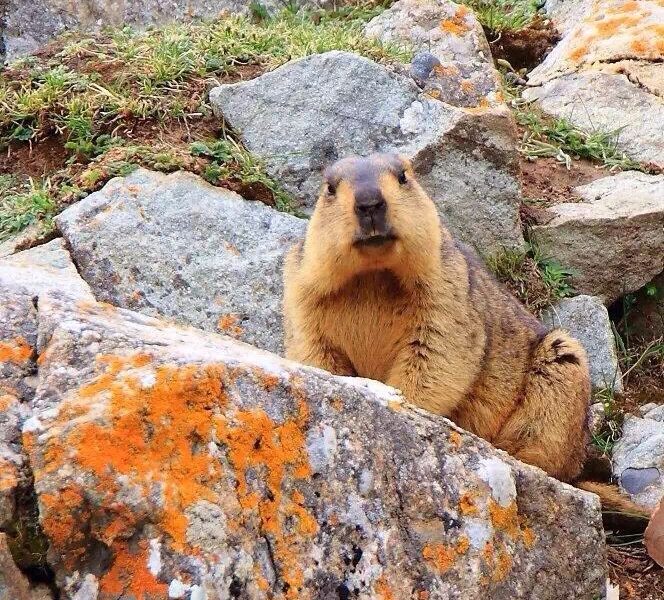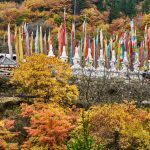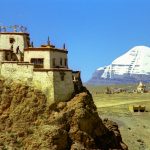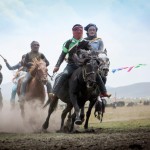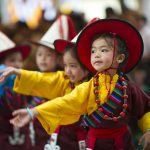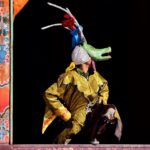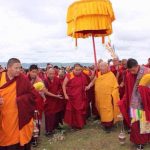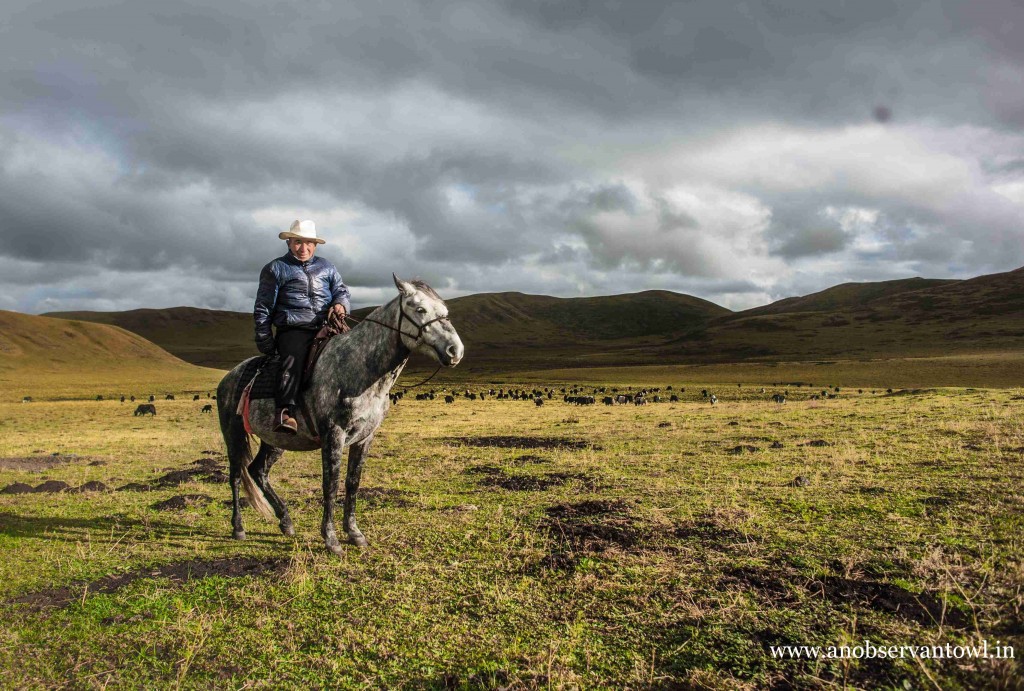Tibet is a vast plateau at the rood of the world. Tibet traditional nomadic culture was greatly influenced by the introduction of Buddhism from India, to an extent that nearly all the cultural achievements of Tibet are related to the Buddhist religion. Because of the predominance of Tantra with its rich tradition of symbolism, it is no surprise that symbols and symbolic artifacts of all sorts are found in Tibet.
Some of the symbols however originated in Tibet, or were given a specific meaning within the local culture. Therefore, Tibet traditional culture attracting more and more western people to discover Tibet, join us to be the witness of Tibet culture and people’s life.
The Eight Auspicious Symbols
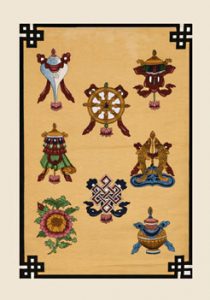
The Conch Shell – An emblem of power, authority, and sovereignty whose blast is believed to banish evil spirits and avert natural disasters.
The Dharma Wheel – The ancient symbol of creation became the symbol of spiritual and universal law in Buddhism. The hub of the wheel symbolizes moral discipline, the eight spokes – the Noble Eightfold Path, and the rim – meditative concentration.
The Parasol – The traditional symbol of protection and royalty. The umbrella protects from all obstacles, illnesses and harmful forces.
The Victory Banner – The emblem of Buddha’s victorious enlightenment and the methods for overcoming worldly defilements.
The Knot of Eternity – represents the meditative mind. It is an endless knot that overlaps without a beginning or an end. – symbolizing the Buddha’s endless wisdom and compassion.
The Golden Fishes – represent happiness, fertility and abundance
The Lotus – The symbol of absolute purity and compassion. It represents spiritual unfoldment – the transmutation of passion into compassion.
The Treasure Vase – The divine vase of inexhaustible treasures possessing the quality of spontaneous manicefestation.
The Four Harmonious Brothers
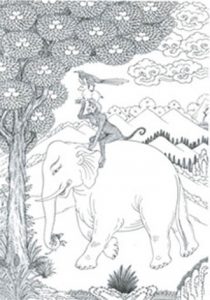
This is a popular Tibetan image, which can be found on murals in Tibetan monasteries quite often. The scene refers to a Buddhist legend that tells of four animals that were trying to find out who could be considered as being the oldest.
The elephant said that the tree was already fully grown when he was young, the monkey that the tree was small when he was young, and the hare that he saw the tree as a sapling when he was young, and the bird claimed that he had carried the seed from which the tree grew. So the bird was recognized by the other three animals as the oldest, and the four animals lived together in harmony, helping each other to enjoy the fruits of the man.
It is also said that wherever a picture of the four harmonious brothers is displayed, the ten virtues will increase, the minds of all will become harmonious and auspicious events will happen!
The Six Symbols of Longevity (Tsering Nam Tuk)
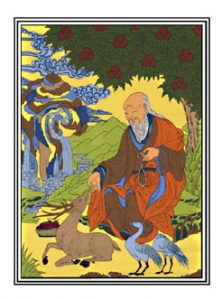
The image of the Six Symbols of Longevity are of Chinese origin but appears often in Tibetan secular art. The old man of long life is Shou-lao, the ancient Chinese God of Longevity. As Buddhism became prominent – the old man came to represent the contemplative sage who manifests the qualities of Amitayus –Vajrayana Buddhism’s deity of Longevity. The sage holds a crystal rosary symbolizing continuity and purity.
The tree of longevity under which the old man sits is the divine peach tree imbued with many medicinal qualities.
The conch-shell-shaped immutable rock of longevity has beneficial geomantic properties.
The stream of longevity springs forth from the rock. It’s pure water is the Nectar of Immortality which is contained in the vase held by Amitayus.
The cranes, believed to live long lives, are ancient Chinese longevity symbols. A pair of cranes symbolize happiness and fidelity.
It is said that deer are the only creatures capable of locating the plant of immortality. In this drawing the sage feeds a piece of the plant of immortality to the deer at his feet.
The Dharma Chakra is the Symbol of Universal and Spiritual Law. Its spokes represent the Noble Eight-Fold Path. In the center is a Double Dorje, the adamantine symbol of sovereign power and indestructible mind.
The Four Dignities
The Four Dignities are mythical animals which represent various aspects of the Bodhisattva attitude, like strength, protection and cheerfulness。
Dragon

The Dragon thunders in the sky with the sound of compassion that awakens us from delusion and increases what we can know through hearing. Dragons have the power of complete communication. Just as we do not see sound, we do not see dragons — at least not usually. Displaying a dragon banner is said to protect one from slander and enhances one’s reputation.
Associations: main quality is power, dominance over the sea, and the water element.
Tiger
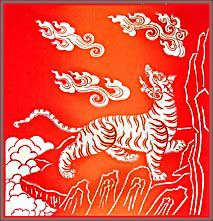
The Tiger abides in the South, symbolizing unconditional confidence, disciplined awareness, kindness and modesty. It is relaxed yet energized; resting in a gentle state of being that has a natural sense of satisfaction and fulfillment, referring to the state of enlightenment.
Associations: main quality is confidence, dominance over forest, and the air element.
Snow Lion
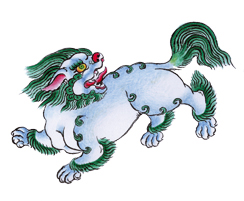
The Snow Lion resides in the East and represents unconditional cheerfulness, a mind free of doubt, clear and precise. It has a beauty and dignity resulting from a body and mind that are synchronized. The Snow Lion has a youthful, vibrant energy of goodness and a natural sense of delight. Sometimes the throne of a Buddha is depicted with eight Snowlions on it, in this case, they represent the 8 main Bodhisattva-disciples of Buddha Shakyamuni, the historical Buddha.
Associations: main quality is fearlessness, dominance over mountains, and the earth element.
Garuda
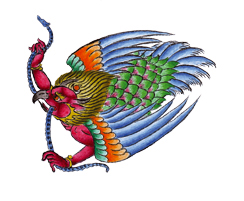
The Garuda is daring and fearless and abides in the north. With great strength and power it soars beyond without holding back. It symbolizes freedom from hopes and fears, the vast mind without reference point. It is a powerful antidote to the negative influences of Nagas (spirits) which can cause disease and all kinds of harm.
Associations: main quality is wisdom, dominance over the sky, and the fire element.
The Dorje
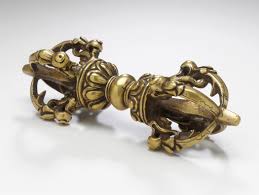
The Dorje (Sanskrit: Vajra) is the Diamond Scepter, the symbol of the unborn, undying, unchanging and indestructible state of enlightenment. It represents Buddha Mind – the clear and empty essence of reality. The crossed “Universal Dorje” symbolizes the principle of total stability and immortality.
Wind Horse
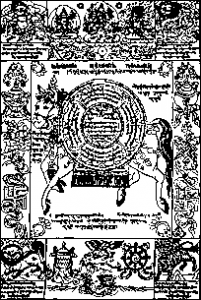
The Wind Horse (Tib. Lung-ta), a mythical Tibetan creature from pre-Buddhist times, combines the speed of the wind and the strength of the horse to carry prayers from earth to the heavens. Not surprisingly in a country where the horse was used by the traditional nomads of Tibet. It is associated with success and the space element. The Wind Horse carrying the “Wish Fulfilling Jewel of Enlightenment” is the most prevalent symbol used on prayer flags. It represents good fortune; the uplifting life force energies and opportunities that make things go well. When one’s lung-ta is low obstacles constantly arise. When lung-ta is high good opportunities abound. Raising Wind Horse prayer flags is one of the best ways to raise one’s lung-ta energy.
“The traditional Wind Horse Prayer Flags are ancient designs. In the center of the flag on the right, is the Wind Horse, the uplifting energy that carries good fortune to all beings. In the corners are the “Four Dignities”: the Garuda (wisdom), the Dragon (gentle power) the Snow Lion (fearless joy), and the Tiger (confidence). The Eight Auspicious Symbols are depicted around the perimeter. Various prayers and mantras are included in the text.
At the top center are the three main Bodhisattvas: Avalokiteshvara (Compassion), Manjushri (Wisdom), and Vajrapani (Power). At the bottom center are the figures called “the union of enemies” representing friendship. The two swastikas are symbols of eternal life. There are many prayers for health, prosperity and good fortune.”
The Kalachakra
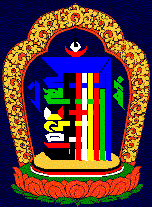
This symbol can be found nearly everywhere where Tibetan Buddhism is present, in various forms. It represents the teachings of the Kalachakra tantra, one of the most complex tantric systems. This symbol was developed in Tibet and is a schematic representation of letters in the Lantsa script. The symbolism behind this logo is vast and has explanations referring to the outer world, the human body at its gross and subtle levels, and the practice of Kalachakra.
The Wheel and Deer Emblem
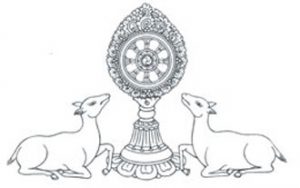
The Buddhist emblem of a golden eight-spoked wheel flanked by two deer represents the Buddha’s first sermon, which he gave in the Deer Park at Benares.
Tibetan Stupas (Tib: Chorten)
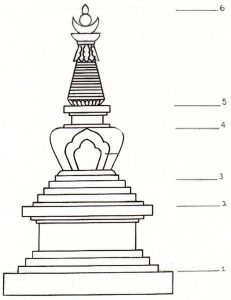
It is well known that stupas originated before the time of the Buddha. In prehistoric times, a stupa was just a mound, located in a remote place, where the bones or relics of a cremated king were placed. (In Sanskrit, the word “stup” means “to heap up, pile, raise aloft, elevate”. ) Twenty-five hundred years ago, at the time of Shakyamuni Buddha’s death, a change came about in the way stupas were regarded.
The Buddha requested that his relics be placed in a traditional stupa, but with a shift in context. Instead of being located in a remote place of honor, the stupa was to be located at a crossroads, so that people passing by would be reminded of the awakened state of mind.
Since the time of the Buddha’s death, stupas are no longer used to revere the dead. “Stupa” in Tibetan is “chorten” or “the basis of offering”, implying a basis for lay people to express devotion and connection to enlightened mind.
A stupa is an architectural representation of the entire Buddhist path as well as the result of the path — the body, speech, and mind of an enlightened being. In particular, the serene, sacred presence of a stupa projects the wise and compassionate minds of our teachers in order to remind us, as well as those not yet born, that we have the potential for enlightenment. A stupa calls to you, and you are the stupa.
A stupa is intended to stop you in your tracks.
What is a Stupa?
There are three representations of the Buddha– body, speech, and mind. Actual statues are representations of Buddha’s holy body. The scriptures represent Buddha’s holy speech. And stupas are the representation of the Buddha’s holy mind.
Stupas are also called “the embodiment of wisdom”. Stupas reveal the path to enlightenment, how an ordinary mind can be transformed into an enlightened mind.
Speaking generally of Buddhist practices, there are three main types:
The foundation
The path
The result
The stupa shows all three. The base (1) and the throne (2) of the stupa are the ethical foundation of all Buddhist practice. The steps (3), vase (4), and harmika (5) are the path, the actual practices. Then the pinnacle (6) represents the result of the practices, the enlightened mind.
Thangka Painting
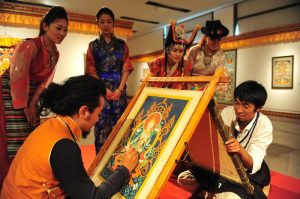
A thangka is a traditional Tibetan painting of a Buddha, Buddhist deity, or a mandala. Thangkas are framed in rich, colorful, silk brocades, but they are religious objects, not simply decorations. Such religious works of art function as models on which meditators can reflect, identifying and developing within themselves the qualities such as wisdom and compassion that are embodied in the painting.
Thangka painting is strictly governed by iconographic rules. An artist spends many years as an apprentice, drawing and studying ancient texts under a master. By the end of the apprenticeship, artists are not only technically trained to produce meticulously detailed works, but are also taught by their teachers to actively seek spiritual calm and moral fortitude. Traditionally, as part of this process, thangka painters observed disciplines such as abstaining from meat, alcohol, onions, and garlic, as well as maintaining strict personal cleanliness. Today, however, they do not always do so.
Traditionally, thangkas were created on commissions from religious devotees, and were not sold on the open market. Today, some highly skilled Thangka artists still work on commission. Less refined thangkas are produced in bulk for tourist markets in Tibet, China, Nepal, India, and elsewhere.
Sacred Mandala
One of the richest visual objects in Tibetan Buddhism is the Mandala.
A Mandala is a symbolic picture of the universe. It can be a painting on a wall or scroll, created in coloured sands on a table, or a visualisation in the mind of a very skilled adept.
The mandala represents an imaginary palace that is contemplated during meditation. Each object in the palace has significance, representing an aspect of wisdom or reminding the meditator of a guiding principle. The mandala’s purpose is to help transform ordinary minds into enlightened ones and to assist with healing.
The Tibetan mandala contains deities, with the principal deity in the centre of the pattern. The deities who reside in the palace embody philosophical views and serve as role models.
